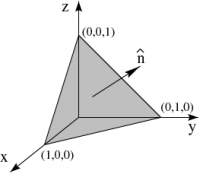You are here: start » courses » hw » syhw » syhwchargedensity
Homework for Symmetries
- (dAdTauMemorize)
Write down $\vec{dA}$ for each of the surfaces of a rectangular prism, a finite cylinder, and a sphere.
Write down $d\tau$ in rectangular, cylindrical, and spherical coordinates.
- (IceCreamMass)
Use integration to find the total mass of ice cream in a packed cone (both cone and hemisphere of ice cream on top).
- (ConeSurface)
Using integration, find the surface area of a cone.
- (TotalCharge)
For each case below, find the total charge.
A positively charged (dielectric) spherical shell of inner radius $a$ and outer radius $b$ with a spherically symmetric internal charge density $\rho(\rr)=\alpha\, 3e^{(kr)^3}$
A positively charged (dielectric) cylindrical shell of inner radius $a$ and outer radius $b$ with a cylindrically symmetric internal charge density $\rho(\rr)=\alpha\, {1\over s}\, e^{ks}$.
- (CubeCharge)
Charge is distributed on the surface of a dielectric cube with charge density $\sigma=\alpha z$, where $z$ is the height from the bottom of the cube, and where each side of the cube has length $L$. What is the total charge on the cube? Don't forget about the top and bottom of the cube.
- (CosmicAsimov)
You are part of the team building Cosmic AC, Asimov's ultimate, universe-sized computer. Your job is to fabricate a charged disk, 10 meters in radius and 1 cm thick. The charge density on the disk should be:
$$\rho=\alpha e^{-\beta s^2} \cos(\gamma z)$$
What is the total charge on the disk, in terms of the parameters $\alpha$, $\beta$, and $\gamma$?
What are the dimensions of $\alpha$, $\beta$, and $\gamma$?
Design specifications indicate that: the maximum charge density should be $27 \frac{C}{cm^3}$, only one-half period of the $\cos(\gamma z)$ term spans the whole height of the disk, the upper and lower circular surfaces have zero charge density, and the maximum values of the charge density on the circumference of the disk should be 10 percent of the maximum in the center. Find values for $\alpha$, $\beta$, and $\gamma$.
What is the total charge on the disk?
Estimate how much error your would make in your calculation of the total charge density if you assumed that the disk was infinitely wide. (Keep the same functional dependence for the charge density, i.e. do not change the values of $\alpha$, $\beta$, and $\gamma$.)
Given the relative sizes of the radius of the disk and the thickness of the disk, it might be reasonable to approximate the disk as infinitely thin. In this case, you might want to describe the charge density as a surface charge density $\sigma$ rather than as a volume charge density $\rho$. From the given volume charge density $\rho$, find an equivalent surface charge density.
- (Helix)
A helix with 17 turns has height $H$ and radius $R$. Charge is distributed on the helix so that the charge density increases like the square of the distance up the helix. At the bottom of the helix the linear charge density is $0 {\hbox{C}\over\hbox{m}}$. At the top of the helix, the linear charge density is $13 {\hbox{C}\over\hbox{m}}$. What is the total charge on the helix?
- (ChargeGraph)
The following graph represents the charge density on a thin piece of plastic (dielectric). Find the charge on the segment between centimeter 3 and centimeter 10.
- (NonuniformDiskQE)
- (ThetaDeltaSJP)
